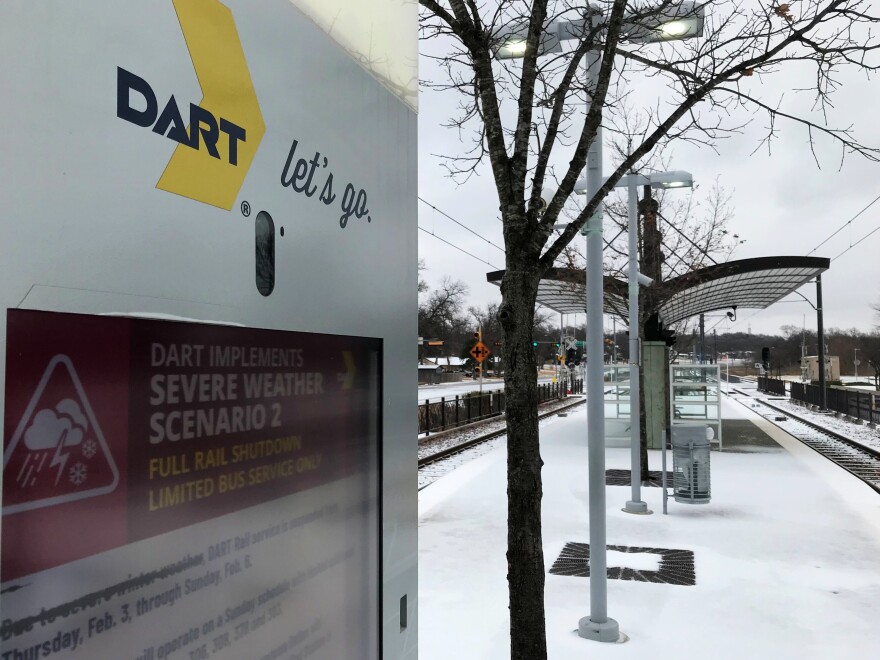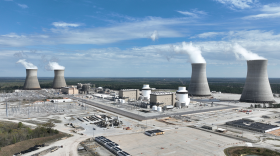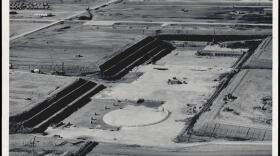
Texas was hit by one of the worst ice storms in its history in February 2021 — bringing freezing temperatures, snow and ice to a state that isn’t used to any of the above.
On the one-year anniversary of Winter Storm Uri, the Texas Tribune released a video of anonymous residents describing the situation.
“It brings me to tears to even think about it now,” one Texan said, “because I lost so much that I can’t replace.”
The storm was especially destructive for the electrical grid, as power generators simply couldn’t keep up with demand. Blackouts left 9.9 million people in the United States and Mexico without power for days. Those who had power still were urged to use less, even in the freezing cold.
KUT reported that the power grid in Texas was only 4 minutes and 37 seconds away from completely collapsing. That would have left residents powerless for months. Not only that, but natural gas wells froze, and half the state saw water service disrupted.
As it was, nearly 250 people in the state died.
“None of my students had access to water,” remembers Dr. Kate Biberdorf (aka Kate The Chemist), a professor at The University of Texas at Austin and the host of the KCUR Studios podcast Seeking A Scientist. “I was driving all over Austin delivering cases of water to dorms and apartment complexes for weeks. It was a legitimate humanitarian crisis down here.”
On the latest episode of Seeking a Scientist, Biberdorf explains how extreme weather is exposing vulnerabilities in the country’s electrical grid, and speaks with scientists and economists to ask how quickly we can shift toward sustainable energy.
What happened in Texas?

The 2021 blackouts in Texas were caused by a combination of a poorly managed grid, and a failure to winterize natural gas infrastructure and wind turbines.
Why? The United States has three major electrical grid systems: Western, Eastern, and Texas. When states in the Eastern or Western systems have issues, like bad weather or when a line fails, they can help each other out and send electricity to the other side of the country.
But Texas stands alone as the sole independent energy grid in the United States. It’s regulated by ERCOT, the Electric Reliability Council of Texas, and Texans are quick to point out the irony in the name.
The Texas Monthly described the state’s electrical grid as being “built to keep prices relatively low most of the time, at the expense of reliability in extreme weather.”
But at this point, Texans can no longer expect to have calm winters. Just a decade ago, a Groundhog Day blizzard caused 75% of the state of Texas to experience rolling blackouts, leaving 19.2 million people without power for days.
How does an electrical grid work?
We produce electricity by burning fossil fuels or using renewable energy, like solar panels and wind turbines. That energy then gets sent across long distances using high-voltage transmission lines.
These lines then go to local facilities called substations, where the power is “stepped down” (i.e. converted from high-voltage to a lower voltage). This is the power that you use at home and at work.
The Western and Eastern grids have capacity to store leftover energy, but the Texas grid does not.
Energy economist Ed Hirs compared it to a hog farmer who doesn’t provide enough food for his animals. “Some of them are gonna die,” says Hirs. “They're not gonna make it.”
What causes blackouts?

During a winter storm, blackouts can occur from weather-related events, like if a downed tree knocks over a transmission line. But usually power can be restored relatively quickly, as soon as that location is repaired.
But blackouts can also happen because people in the affected communities all turn on their heaters, their ovens or their stoves in an attempt to stay warm.
When there isn’t enough energy generated to service the consumer demand, state agencies and grid operators may cut off power to different parts of the affected areas to help reduce stress on the grid. And they rotate it to prevent any one community from being without power for too long — aka “rolling blackouts.”
It’s a strategy called load shedding, which can help prevent the whole grid from experiencing a catastrophic failure.
“For example, maybe the city of Austin lost power for an hour and a half,” Hirs says. “Maybe the city of Dallas would lose power for 30 minutes here, 40 minutes there.”
But it doesn’t impact everyone equally. If you live on the same grid as the hospital or a water plant, you are much less likely to lose power.
And it wasn't just Texas: Parts of Kansas and Missouri saw rolling blackouts in that 2021 winter storm.

In some countries outside of the United States, load shedding is a part of regular life — including for the more than 59 million residents of South Africa.
Mike Rahfaldt, a journalist living in South Africa, uses an app to predict when the power will be on or off, due to the real-time strains on the grid.
“So, all of a sudden, at a moment's notice, we can be told that the power's going to go off in about 15 minutes,” Rahfaldt says.
For work, Rahfaldt has a backup inverter that he can use for reliable Wi-Fi. He also has a backup battery to charge his laptop, but it seems to be deteriorating.
Even with both of these devices, he’s constantly thinking about when he can charge his devices to make sure that he can keep working. Not to mention the other electricity-reliant parts of his life.
“I live in constant fear of jumping into that elevator, and not realizing that it's time for the power to shut off, and getting stuck for two hours,” Rahfaldt says.
How can we make a more sustainable electrical grid?

The future of energy in the United States will require turning away from fossil fuels like coal and oil - which are not just dwindling in supply, but also destructive to the environment (they’re by far the largest contributor to global climate change) and damaging to our health.
According to The International Renewable Energy Agency (IREA), that primarily means investing in wind and solar energy. Some studies suggest that natural gas (which is still a fossil fuel) may still be useful as a backup for storms and extreme weather.
But achieving that balance of energy sources is easier said than done.
Back in 2006, California made the unprecedented commitment to go green with their energy sources.
Lawmakers passed ambitious climate change legislation called the Global Warming Solutions Act. The goal was to have 20% of California’s electricity produced by renewable resources by 2010, and up to 33% by 2020.
The hope was that by combining regulations, incentives, and asking people to do their parts, the state could reduce greenhouse gas emissions. The plan focused efforts on motor vehicles, fuels, and electricity production.
The sunshine state has made a lot of progress, creating networks of wind turbines, retiring three big natural gas plants, and pushing automakers to produce competitive zero-emission vehicles.
But with temperatures still rising and a population rapidly growing, the state still suffers from rotating blackouts during peak electricity usage, like right after work, when everyone is trying to make dinner and watch TV. Or on hotter days when people all come home and immediately turn on the air conditioning.
Stephen Berberich, the former president of the California Independent System Operator (CAISO), says that California’s electrical grid has left many in the dark more often than he would have liked.

Hirs calls the examples in Texas and California “the canary in the coal mine” when it comes to the future of electricity reliability in the United States.
In 2020, when the new CEO of the CAISO, Elliot Mainzer, took office, he immediately convinced the California legislature to pass a law that would help prop up natural gas plants.
Scientists and environmentalists were not happy about this decision. One study shows that natural gas caused carbon dioxide emissions to increase by 2.6% per year over the last decade.
However, California is still well ahead of the rest of the nation. Their current power breakdown is about 40% natural gas, 14% solar, 11% wind, 9% nuclear, and 9% hydro. The remaining 17% comes from a mixture of coal, geothermal, and biomass.
In 2022, the state even logged one full day -- the sun was out and the wind was blowing — when it was able to run 100% on renewable energy. Nuclear power and large hydroelectric also contributed, but California does not consider them to be “renewable.”
Is nuclear power the future of energy?

Countries in the Asia Pacific region, like China and India, are moving in a different direction. They are going nuclear.
By 2027, India will have eight new nuclear reactors, and China is hoping to have 20. Right now, China’s current energy generation from nuclear power is just over 2%.
And a massive breakthrough last year has put renewed momentum behind nuclear — and specifically nuclear fusion — as the future of energy.
Maria Korsnick, the president and chief executive officer of the Nuclear Energy Institute, is one such believer.
“The scale of this electric grid that's across the United States, it needs something that's always there, something that can help really be the backbone,” she told the AP. “That's why it's a partnership with wind and solar and nuclear."
Nuclear fission is something we’ve been doing for decades already. It occurs when we bombard a large atom with neutrons, forcing it to split apart into smaller atoms. This process releases a lot of heat, which we can then convert into electricity for nuclear submarines, weaponry and power plants.
But fusion, the recent breakthrough, is different. “If you think about fission as splitting atoms apart, you can think of fusion as putting atoms together,” says Adam Stein, the director of Nuclear Energy Innovation at The Breakthrough Institute.
This past December, researchers from the National Ignition Facility, located at the Lawrence Livermore National Laboratory, performed a groundbreaking experiment that used 192 lasers to fuse two specific hydrogen isotopes together, forming one helium atom.

Stein says this is the first time we’ve ever done what is called fusion ignition, the same chemical process that powers the sun — which is self-sustaining in its heat generation.
The trick is, these small atoms do not want to bond, kind of like forcing two magnets together. But the result is that more energy is produced from the reaction than went into it.
“This was what's known as net gain,” Stein says.
You can compare fusion ignition to a magical bank transaction: if you were to put $5 into your bank account, and then somehow, $10 happens comes out. With this extra money, you can then make more transactions to generate even more income.
Theoretically, the extra energy from a fusion ignition reaction can be used to perpetuate the reaction so it can run without any additional help from scientists.
That would be a total game-changer for energy generation in the United States.
How safe is nuclear power?
According to a recent Gallup survey, Americans support nuclear energy as an electricity source at the highest rate in a decade. But because of a few high-profile accidents at nuclear fusion plants — most recently at Fukushima in 2011 — it remains controversial to many.
However, Stein says the concerns are a bit overblown: “One pet peeve the media usually gets wrong is the risks of nuclear power.”
“Nuclear power is by the numbers with evidence the safest form of energy of all major sources of energy we have,” Stein says. “It's safer than wind and solar because unfortunately there's accidents either installing or maintaining wind and solar and it’s definitely safer than fossil fuels.”
In reality, if you live in the United States, you are already getting nearly 20% of your energy from nuclear power. However, some concerns around the safety of uranium mining and waste remain.
Unlike nuclear fission power plants, fusion plants would neither use uranium fuel rods nor would they produce any nuclear waste. Instead, they would use safer starting materials, like deuterium and tritium, two different types of hydrogen, and produce helium — the gas used in birthday balloons.
However, even with these advances in nuclear fusion, Stein says you shouldn't throw away your generators just yet. He predicts the first successful nuclear fusion power plant will not be online until 2045.
Where can I hear more about this topic?
Listen and subscribe to Seeking A Scientist with Kate The Chemist, from KCUR Studios, available wherever you listen to podcasts.

Seeking A Scientist is a production of KCUR Studios, made possible with support from the Stowers Institute for Medical Research and design help from PRX.
This episode was produced by Dr. Kate Biberdorf, Suzanne Hogan and Byron Love, edited by Mackenzie Martin and Gabe Rosenberg, with help from Genevieve Des Marteau.
Our original theme music is by The Coma Calling. Additional music from Blue Dot Sessions.
Copyright 2023 KCUR 89.3. To see more, visit KCUR 89.3. 9(MDA4OTAxNzAzMDEzMjc0MTc2MzA5ZDZlMw004))






